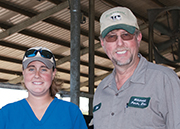
Ninety-eight degrees in Georgia feels a good bit different than 98° in California. In Georgia, we have some of the worst humidity imaginable. There are some weeks during the summer that temperatures stay in the low 100° range.
For us, putting our milking herd in a freestall barn has done wonders for cow health and production. What about our close-up dry cows that are still out on pasture though? How does heat throughout the dry period affect them in their vital first three days postpartum?
The best scenario for a Georgia dairy farmer is to have milking and dry cows under a roof with fans, sprinklers, and so forth, but as many of you know, our pockets only run so deep, especially with milk prices where they are at right now. So, how do we protect the cows housed outside from the extreme heat?
While on pasture during the dry period, we do everything possible to keep our cows in good health. Every day these cows are looked at individually eight times a day. They are fed a special ration to support their pregnancy needs and to prepare them for calving. We also have a covered feedbunk with fans so that while eating they can get cooled off.
Once they have calved is when you can really tell how the heat has stressed their bodies. This is why we pay such close attention to them for the first few days. After calving, we move them to the freestall barn within the first few hours.
At this point, we put them into a chute and give them a full examination. We automatically give each individual cow the calcium supplement Bovikalc, an oral dose of probiotic, and we also trim their tails. Once the examination is over, we release them into a hospital pen. We revisit the fresh cows throughout the day to make sure they are eating and drinking well. We do a last walk around before dayshift crew leaves to make sure none of the cows need a re-examination. They stay in the pen for the first three days postpartum so that they may have our utmost attention day and night.
Goals and visions of Hillcrest's future include a transition barn. This would help the cows with heat stress tremendously. We would be able to control temperature, air movement, and feed intake so that we would be feed a total mixed ration without the consumption of grass or dry hay to tightly manage what they consume. In addition, we would be able to have a clean, lush bedded area for calving. Until then, we will keep doing the best we can with our current situation and keep an especially close eye on those fresh cows.
 Mark and Caitlin Rodgers are dairy farmers in Dearing, Georgia. Their "Daddy and Daughter Dairy Together" column will appear every other Thursday on HD Notebook. The Rodgers have a 400-cow dairy that averages 32,000 pounds of milk. Follow their family farm on Facebook at Hillcrest Farms Inc.
Mark and Caitlin Rodgers are dairy farmers in Dearing, Georgia. Their "Daddy and Daughter Dairy Together" column will appear every other Thursday on HD Notebook. The Rodgers have a 400-cow dairy that averages 32,000 pounds of milk. Follow their family farm on Facebook at Hillcrest Farms Inc.